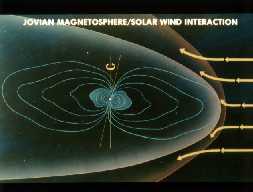The New Horizons mission may have one primary target, the Pluto/Charon binary at the edge of the Kuiper Belt, but the science along the way should be interesting indeed. Up next in late February is the Jupiter flyby, whose powerful gravity assist will boost New Horizons’ velocity past 23 km/s and provide the needed stress tests to put onboard instrumentation through its paces and refine the methods for data collection. But there’s plenty to do in Jupiter space beyond setting up for the 2015 Pluto encounter.

For one thing, Jupiter’s magnetosphere extends far beyond the planet itself, and New Horizons will be the first probe to move along the ‘tail’ of this stream of charged particles. These studies will complement the earlier magnetosphere work of Cassini and Galileo. All told, 700 observations of Jupiter and the Galilean moons are planned, with data gathering from January through June, including looks at the ring system and a close-up look at the ‘Little Red Spot’ the storm that’s brewing to the south of its much larger cousin.
Image: Jupiter’s magnetosphere diagrammed. Note the bullet shape defined by the incoming solar wind. New Horizons will move along the ‘long tail’ of this stream of particles. Credit: NASA.
New Horizons is currently 5.57 AU from Earth, moving at a heliocentric velocity of just under 20 km/s. As with any space mission, we wait for data, much of which will be stored on the spacecraft’s onboard recorders until March, when the main antenna will be re-oriented for transmission to Earth. The Pluto approach and encounter will involve five months of observations that should fill huge gaps in our knowledge of the distant world and its moons. Whether an additional Kuiper Belt object will also be investigated depends upon the mission’s status after Pluto, but as the Mars rovers have demonstrated, extended missions can surprise us with the resilience of their hardware and the depth of their results.


Hi Paul
A way to land scientific payloads on Pluto, via a fly-by probe bus, is to use a ballute as a drag device – puts the lander through a lot of gees and needs some means of braking from a 100 m/s fall, but according to the analysis I read it was quite feasible. Either a Penetrator mission or super-tough landing-balloons might be enough to keep the weight down.
But the best way to get landers to the Outer System is to have faster interplanetary drives – a MITEE NTR stage is one good option. Then we might reduce the trip times to a few years instead of decades.
Cool..
On plutos wikipedia page, the {dwarf} planet is still a pixelated circle. Should be real interesting to see whats out there.
And thats a hell of a magnetosphere
At least it’s nice to know that, thanks to New Horizons,
Clyde Tombaugh will become the first person to leave
the Sol system.
http://www.jhuapl.edu/newscenter/pressreleases/2006/060203.asp
And a commemorative Florida quarter. :^$
http://www.nasa.gov/mission_pages/newhorizons/main/fl_quarter.html
I hope you do not mind if I add you to my “Blogs of Interest?”
So, when does New Horizons pass Voyager I?
Never. New Horizons won’t get the gravity boost that Voyager I got from Jupiter. So, it won’t go as fast. So, it will never catch up (even in absolute distance).
Any word on targets beyond Pluto?